If you are unfamiliar with the genetic history of humanity presented in The Urantia Book, the Topical Study: Genetic Introductions, Mutations, and Evolution: a Urantia Book perspective will help you get up to speed on that subject.
In short, humanity’s genetic origin began with a mutation that occurred 1,000,000 years ago. These people are called Andonites. The mutation did not produce sufficient intelligence for civilization to develop. Another mutation occurred 500,000 years ago near Afghanistan, giving rise to six colored races. To greater and lesser degrees, all of these races possessed sufficient intelligence for the development of civilization. Genetic develops occurred around 200,000 years ago and 37,000 years ago that do not summarize easily. But suffice it to say, these relate to the Nodites and Adamites, respectively. The mix of Nodite and Adamite is termed Andite. Nodites relates to our poorly preserved records of the Nephilim, who, during the times of Adam, had a cultural center known as the Land of Nod.
UBtheNEWS: Gobekli Tepe Report sections:
Gobekli Tepe Summary
Gobekli Tepe Review
xxxxThe Urantia Book perspective
xxxxUncovering the mysteries at Gobekli Tepe
xxxxArt, Architecture, and Culture
xxxxAncient Scientific Teachings and Spiritual Practices
Gobekli Tepe Additional Updates since publication of the original report.
Gobekli Tepe Summary
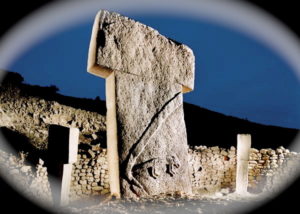 In 1994, almost forty years after The Urantia Book’s 1955 publication, excavations began at the Gobekli Tepe archaeological site in Turkey. The Gobekli Tepe site already reveals 50 engraved stone monoliths, some of them dating back to 12,000 years ago. Some of them are at least 6,000 years older than Stonehenge and the Egyptian pyramids. A full excavation to the bottom of the site has not yet occurred, and only a small percentage of the site has been uncovered. The evidence suggests that the complex of round rooms with two especially large pillars in the middle were built for religious rather than practical purposes. Gobekli Tepe is widely acknowledged as one of the most important and mysterious archaeological sites in the world. The two main mysteries surrounding Gobekli Tepe are:
In 1994, almost forty years after The Urantia Book’s 1955 publication, excavations began at the Gobekli Tepe archaeological site in Turkey. The Gobekli Tepe site already reveals 50 engraved stone monoliths, some of them dating back to 12,000 years ago. Some of them are at least 6,000 years older than Stonehenge and the Egyptian pyramids. A full excavation to the bottom of the site has not yet occurred, and only a small percentage of the site has been uncovered. The evidence suggests that the complex of round rooms with two especially large pillars in the middle were built for religious rather than practical purposes. Gobekli Tepe is widely acknowledged as one of the most important and mysterious archaeological sites in the world. The two main mysteries surrounding Gobekli Tepe are:
1) How did people this primitive cut, carve, move, and build with enormous stones in excess of 15 tons? The artifacts are inconsistent with prevailing theories about the development of civilization because every place else in the world, where ancient civilizations have built structures with enormous stones, there is also evidence of settled communities that practiced herding and agriculture. Prevailing theories about this region suggest that around 11,000 years ago, primitive man was just beginning to evolve from being a hunter-gatherer to a herder-farmer.
2) Why did this civilization decline over a period of several thousand years and then intentionally bury the site around 10,000 years ago? One of the peculiar aspects of the construction and art at Gobekli Tepe is that both become less refined over time. The older structures are significantly larger and more ornately decorated. There are clear indications that the site was intentionally buried but nothing to indicate why.
The Urantia Book answered these questions forty years before we discovered this mysterious site existed. The history of humanity provided by the authors of The Urantia Book recounts that a genetically superior and well-developed herder-farmer civilization existed in this area over 30,000 years ago. They also explain why this particular civilization experienced a prolonged genetic degradation and, therefore, cultural decline. Additionally, The Urantia Book says that, due to population pressures, inferior and more barbaric tribes drove out this more peaceful and advanced civilization.
Adding powerfully to the intrigue of this report is its relationship to the Adam and Eve Report and the Garden of Eden Report. These two reports also happen to reveal some of the most impressive corroborations of Urantia Book history documented so far by UBtheNEWS. The story of Adam and Eve in The Urantia Book is significantly different from the one found in the Old Testament and centers around a major genetic change that occurred 38,000 years ago. Starting with the Adam and Eve Report provides some background on the genetic issues that are relevant to this report; however, it is not necessary to read that report first in order to understand this one.
Gobekli Tepe Review
Gobekli Tepe is best known for being an archaeological discovery that defies explanation.
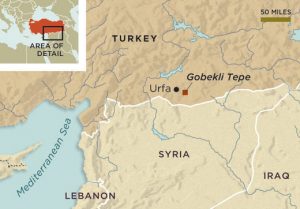 Theories about the history of human civilization are based on evidence that strongly suggests a pattern of progress, both culturally and genetically, over extended periods of time. Progression is what seems to naturally occur; retrogression is the exception. “Survival of the fittest” and successive generations building on the achievements of previous generations are the basic models for genetic and cultural progress. Retrogression occurs, but it requires a special explanation: war, changing climate, unwise cultural practices, overpopulation, something. Gobekli Tepe provides strong evidence of a civilization that was both extremely precocious and also in decline for thousands of years. Eventually, the area became populated by an inferior civilization. But scholars are reluctant to hypothesize in this direction because it requires reforming widely held theories on the progressive nature of human evolution.
Theories about the history of human civilization are based on evidence that strongly suggests a pattern of progress, both culturally and genetically, over extended periods of time. Progression is what seems to naturally occur; retrogression is the exception. “Survival of the fittest” and successive generations building on the achievements of previous generations are the basic models for genetic and cultural progress. Retrogression occurs, but it requires a special explanation: war, changing climate, unwise cultural practices, overpopulation, something. Gobekli Tepe provides strong evidence of a civilization that was both extremely precocious and also in decline for thousands of years. Eventually, the area became populated by an inferior civilization. But scholars are reluctant to hypothesize in this direction because it requires reforming widely held theories on the progressive nature of human evolution.
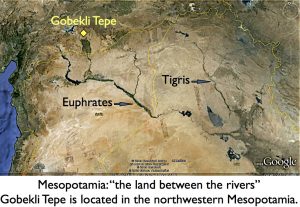 The Urantia Book provides a history of humanity that harmonizes perfectly well with the discoveries being made at Gobekli Tepe. It presents an explanation of the Gobekli Tepe mysteries in terms of an Adam and Eve story that varies significantly from the Old Testament record, but, which the authors assert, is nonetheless the basis for many of our myths and religious traditions about the origins of humanity. Not surprisingly, because of the unusual nature and age of this archaeological site, scholars quickly began speculating on how it may relate to the religious traditions about Adam and Eve. So, in one sense, The Urantia Book’s explanation fits well with scholarly speculations about the significance of Gobekli Tepe. Even still, while demonstrating clear parallels, the unique aspects of the Adam and Eve story found in The Urantia Book, no doubt, will also raise a lot of questions.
The Urantia Book provides a history of humanity that harmonizes perfectly well with the discoveries being made at Gobekli Tepe. It presents an explanation of the Gobekli Tepe mysteries in terms of an Adam and Eve story that varies significantly from the Old Testament record, but, which the authors assert, is nonetheless the basis for many of our myths and religious traditions about the origins of humanity. Not surprisingly, because of the unusual nature and age of this archaeological site, scholars quickly began speculating on how it may relate to the religious traditions about Adam and Eve. So, in one sense, The Urantia Book’s explanation fits well with scholarly speculations about the significance of Gobekli Tepe. Even still, while demonstrating clear parallels, the unique aspects of the Adam and Eve story found in The Urantia Book, no doubt, will also raise a lot of questions.
This report will not attempt to provide all the answers. Some explanations can be found by reading the Adam and Eve Report and the Garden of Eden Report. For a more complete understanding, read Chapters 73 through 80 in The Urantia Book. Additionally, you may want to review theEugenics, Race, and The Urantia Book paper. In January 2011, UBtheNEWS prepared and published the first and only comprehensive review of this topic.
Some information from The Urantia Book about Adam and Eve will be provided first because Gobekli Tepe is itself such a mysterious site. This structure will allow you to immediately put the mysterious aspects of Gobekli Tepe in context as they are reviewed.
The Urantia Book perspective
According to The Urantia Book, many worlds exist like ours that are inhabited by evolutionary mortals, and when evolution reaches an apex, a higher order of beings with superior genetics are sent to the planet to provide further evolutionary development. A pair of biologic uplifters is sent—a male and a female. The authors describe this as being God’s regular plan for creating mortal races and providing for our progressive development. The authors explain that Adam and Eve came to our world as adults, after having received special training on their native sphere for this special undertaking. This order of beings are referred to in The Urantia Book as “Material Sons (and Daughters)” or “Adam and Eve.”
The authors of The Urantia Book recount that Adam and Eve arrived on our world about 38,000 years ago. Unlike the evolutionarily progressive nature of human genetics, Adam and Eve’s genetic contribution is said to have a pattern of diminishing quality from generation to generation. This is because the introduction of their genetics is intended to be an uplifting gift to the mortal races, not the introduction of an other-worldly race destined and designed to dominate.
Two of the reasons provided in The Urantia Book for its existence are 1) “The supplying of information which will fill in vital missing gaps in otherwise earned knowledge,” and 2) “The restoration of important bits of lost knowledge concerning epochal transactions in the distant past.” (101:4.8,9) The arrival of Adam and Eve constitutes an epochal transaction in the distant past—more specifically, an epochal genetic uplift. Consistent with some of the general themes found in the Old Testament account, but differing in most all the details, the authors of The Urantia Book indicate that Adam and Eve made some serious mistakes that interrupted the regular progress of genetic uplift. These problems required them to leave their original location.
According to The Urantia Book:
The Adamites greatly excelled the surrounding peoples in cultural achievement and intellectual development. They produced the third alphabet and otherwise laid the foundations for much that was the forerunner of modern art, science, and literature. Here in the lands between the Tigris and Euphrates they maintained the arts of writing, metalworking, pottery making, and weaving and produced a type of architecture that was not excelled in thousands of years. (76:3.8)
They [Adam and Eve’s children] were . . . long-lived, albeit longevity gravitated toward the human norm with each succeeding generation. (76:4.3)
Both the physical and spiritual visions of Adam and Eve were far superior to those of the present-day peoples. . . . These special senses were not so acutely present in their children and tended to diminish with each succeeding generation. (76:4.5)
The Urantia Book uses the term Andites to refer to the civilization that developed in Mesopotamia when significant mixing of the Adamites with the surrounding population occurred. Andites have a relatively high degree of the Adamic inheritance. With respect to Mesopotamia during the time period of Gobekli Tepe, it states:
The [Adamites] . . . retained the Edenic traditions of peacefulness for many millenniums, which explains their long delay in making territorial conquests. When they suffered from population pressure, instead of making war to secure more territory, they sent forth their excess inhabitants as teachers to the other races. (78:3.1)
These Andites inaugurated new advances throughout Eurasia and North Africa. From Mesopotamia through Sinkiang the Andite culture was dominant, and the steady migration toward Europe was continuously offset by new arrivals from Mesopotamia. But it is hardly correct to speak of the Andites as a race in Mesopotamia proper until near the beginning of the terminal migrations of the mixed descendants of Adam. By this time even the races in the second garden had become so blended that they could no longer be considered Adamites. (78:5.2)
The last three waves of Andites poured out of Mesopotamia between 8000 and 6000 B.C. These three great waves of culture were forced out of Mesopotamia by the pressure of the hill tribes to the east and the harassment of the plainsmen of the west. (78:6.1)
This is how The Urantia Book provides an explanation of human history that is altogether consistent with the otherwise perplexing discoveries that continue to be made at Gobekli Tepe— over forty years after it was written.
Uncovering the mysteries at Gobekli Tepe
Scholars are straining to come up with interpretations for Gobekli Tepe for a very good reason. On the one hand, professionalism requires that they avoid getting overly creative with their speculations and interpretations of archaeological and anthropological evidence. And, on the other hand, Gobekli Tepe requires thinking outside the box. With this in mind, we now turn to quotes from a variety of sources (primarily newsweek.com and archaeology.org) about the mystery of Gobekli Tepe.
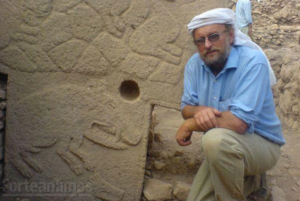 The German archaeologist who has been excavating the site since 1994 sums up four more months of digging. “In 14 years, we have uncovered barely five percent of what is here. There are decades of work ahead,” Klaus Schmidt says. (Archaeo News 12/14/08)
The German archaeologist who has been excavating the site since 1994 sums up four more months of digging. “In 14 years, we have uncovered barely five percent of what is here. There are decades of work ahead,” Klaus Schmidt says. (Archaeo News 12/14/08)
The new discoveries are finally beginning to reshape the slow-moving consensus of archeology. Göbekli Tepe is “unbelievably big and amazing, at a ridiculously early date,” according to Ian Hodder, director of Stanford’s archeology program. Enthusing over the “huge great stones and fantastic, highly refined art” at Göbekli, Hodder—who has spent decades on rival Neolithic [New Stone age] sites—says: “Many people think that it changes everything…It overturns the whole apple cart. All our theories were wrong.” (Newsweek 2/18/10)
[T]he structures not only predate pottery, metallurgy, and the invention of writing or the wheel; they were built before the so-called Neolithic Revolution, i.e., the beginning of agriculture and animal husbandry around 9,000 BC. But the construction of Göbekli Tepe implies organization of an order of complexity not hitherto associated with pre-Neolithic societies. (Wikipedia: Gobekli Tepe)
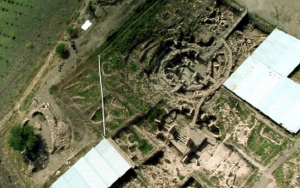 Though not as large as Stonehenge—the biggest circle is 30 yards across, the tallest pillars 17 feet high—the ruins are astonishing in number. Last year Schmidt found his third and fourth examples of the temples. Ground-penetrating radar indicates that another 15 to 20 such monumental ruins lie under the surface. Schmidt’s German-Turkish team has also uncovered some 50 of the huge pillars, including two found in his most recent dig season that are not just the biggest yet, but, according to carbon dating, are the oldest monumental artworks in the world. (Newsweek 2/18/10)
Though not as large as Stonehenge—the biggest circle is 30 yards across, the tallest pillars 17 feet high—the ruins are astonishing in number. Last year Schmidt found his third and fourth examples of the temples. Ground-penetrating radar indicates that another 15 to 20 such monumental ruins lie under the surface. Schmidt’s German-Turkish team has also uncovered some 50 of the huge pillars, including two found in his most recent dig season that are not just the biggest yet, but, according to carbon dating, are the oldest monumental artworks in the world. (Newsweek 2/18/10)
Schmidt and his colleagues estimate that at least 500 people were required to hew the 10- to 50-ton stone pillars from local quarries, move them from as far as a quarter- mile away, and erect them. (2008 Archaeology Vol. 61 No. 6)
Excavations have revealed that Göbekli Tepe was constructed in two stages. . . . Strangely enough, the later remains, . . . [from] about 8000 B.C., are less elaborate. The earliest levels contain most of the T-shaped pillars and animal sculptures. (2008 Archaeology Vol. 61 No. 6)
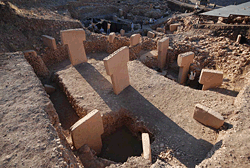 Before the discovery of Göbekli Tepe, archaeologists believed that societies in the early Neolithic were organized into small bands of hunter-gatherers and that the first complex religious practices were developed by groups that had already mastered agriculture. Scholars thought that the earliest monumental architecture was possible only after agriculture provided Neolithic people with food surpluses, freeing them from a constant focus on day-to-day survival. A site of unbelievable artistry and intricate detail, Göbekli Tepe has turned this theory on its head. (2008 Archaeology Vol. 61 No. 6)
Before the discovery of Göbekli Tepe, archaeologists believed that societies in the early Neolithic were organized into small bands of hunter-gatherers and that the first complex religious practices were developed by groups that had already mastered agriculture. Scholars thought that the earliest monumental architecture was possible only after agriculture provided Neolithic people with food surpluses, freeing them from a constant focus on day-to-day survival. A site of unbelievable artistry and intricate detail, Göbekli Tepe has turned this theory on its head. (2008 Archaeology Vol. 61 No. 6)
Schmidt’s thesis is simple and bold: it was the urge to worship that brought mankind together in the very first urban conglomerations. The need to build and maintain this temple, he says, drove the builders to seek stable food sources, like grains and animals that could be domesticated, and then to settle down to guard their new way of life. The temple begat the city. (Newsweek 2/18/10)
Some archeologists, like Hodder, the Neolithic specialist, wonder if Schmidt has simply missed evidence of a village or if his dating of the site is too precise. But the real reason the ruins at Göbekli remain almost unknown, not yet incorporated in textbooks, is that the evidence is too strong, not too weak. “The problem with this discovery,” as Schwartz of Johns Hopkins puts it, “is that it is unique.” No other monumental sites from the era have been found. Before Göbekli, humans drew stick figures on cave walls, shaped clay into tiny dolls, and perhaps piled up small stones for shelter or worship. Even after Göbekli, there is little evidence of sophisticated building. (Newsweek 2/18/10)
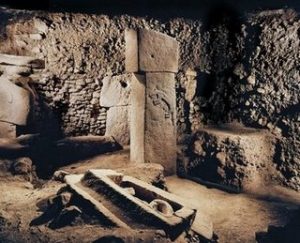 Schmidt . . . continues: “The really strange thing is that in 8,000 BC, during the shift to agriculture, Gobekli Tepe was buried. I mean deliberately – not in a mudslide. For some reason the hunters, or the ex-hunters, decided to entomb the entire site in soil. The earth we are removing from the stones was put here by man himself: all these hills are artificial.” (ForteanTimes March 2007)
Schmidt . . . continues: “The really strange thing is that in 8,000 BC, during the shift to agriculture, Gobekli Tepe was buried. I mean deliberately – not in a mudslide. For some reason the hunters, or the ex-hunters, decided to entomb the entire site in soil. The earth we are removing from the stones was put here by man himself: all these hills are artificial.” (ForteanTimes March 2007)
The temples had been in decline for a thousand years—later circles are less than half the size of the early ones, indicating a lack of resources or motivation among the worshipers. This “clear digression” followed by a sudden burial marks “the end of a very strange culture,” Schmidt says. But it was also the birth of a new, settled civilization, humanity having now exchanged the hilltops of hunters for the valleys of farmers and shepherds. New ways of life demand new religious practices, Schmidt suggests, and “when you have new gods, you have to get rid of the old ones.” (Newsweek 2/18/10)
Probably because long-term cultural decline is not something about which scholars tend to speculate, Schmidt feels he must come up with an explanation for how the decline was actually part of an advance, “the birth of a new, settled civilization.” Because Schmidt cannot construct a reasonable theory for why a superior civilization would be driven out by an inferior one, he assumes that the same general group of people who built and buried Gobekli Tepe continued to live in that area afterwards. Even if he was willing to question some initial assumptions, still, he could never get away with speculating about why a more peaceful and superior civilization eventually got overrun by an inferior culture. But from The Urantia Book perspective, the burial of Gobekli Tepe, in all likelihood, reflects a superior culture not wanting its holy site to be desecrated by their more numerous and less self-controlled neighbors.
Hodder’s critique of Schmidt is of mixed merit. One can always speculate about the accuracy of test results, but in this case, his speculations about the dating seem misplaced. Various levels are being dated with more than one technique. As well, Hodder misses the bigger picture. They have excavated less than ten percent of the site and still have not reached the bottom. The trend is for the architecture to get bigger and more sophisticated the deeper they go. With all of this, the likelihood of Gobekli being dated to more recent times seems remote. However, Hodder’s cautionary concerns about other types of structure and agriculture practices that might as yet be discovered is particularly warranted because so little of the site has been excavated. After all, who could have predicted Gobekli Tepe (aside from the authors of The Urantia Book)? But even if evidence eventually turns up showing that these people were also herder-farmers, this does not explain why Gobekli Tepe was on the decline for such a long time and then buried over.
The decline and burial of Gobekli Tepe is consistent with and suggestive of some type of genetic degradation over time. The uniqueness of the site and its advanced qualities support speculation about a more advanced race. But proposing such theories can be especially controversial and damaging to one’s professional reputation. Gobekli Tepe puts scholars between a rock and a hard place because of challenges to prevailing theories posed by the site. It seems the challenge is so great that it causes scholars to question even the most longstanding, well supported and common sense theories about human progress.
Gobekli Tepe causes Schmidt and others to make speculations like:
First the temple, then the city.
Hunter-gatherers built complex structures using enormous stones without the benefit of the wheel, metal, or math.
Hunter-gatherers had a system of controlling slave labor in order to produce these results. The transition to herder-farmer involves a loss of cultural sophistication in art and masonry.
- First the temple, then the city.
- Hunter-gatherers built complex structures using enormous stones without the benefit of the wheel, metal, or math.
- Hunter-gatherers had a system of controlling slave labor in order to produce these results.
- The transition to herder-farmer involves a loss of cultural sophistication in art and masonry.
On the one hand, it may seem like scholars would rather make speculations that defy common sense than honestly acknowledge when the evidence requires questioning certain fundamental assumptions. On the other hand, if Gobekli Tepe reflects the 20,000-year aftermath of an ill-fated attempt to uplift early humans with extraterrestrial genetics, we cannot blame scholars for not being able to come up with a good explanation of this highly unusual archaeological site.
Art, architecture, and culture
(78:2.4) Adam left a great intellectual and spiritual culture behind him, but it was not advanced in mechanical appliances since every civilization is limited by available natural resources, inherent genius, and sufficient leisure to insure inventive fruition.
(76:3.8) The Adamites greatly excelled the surrounding peoples in cultural achievement and intellectual development. They produced the third alphabet and otherwise laid the foundations for much that was the forerunner of modern art, science, and literature. Here in the lands between the Tigris and Euphrates they maintained the arts of writing, metalworking, pottery making, and weaving and produced a type of architecture that was not excelled in thousands of years.
In the Gobekli Tepe time period, both architecturally and artistically, nothing else compares in size and sophistication to the stonework at Gobekli Tepe. In this regard, the art on the architecture has special significance because it reveals the most advanced expressions of culture to date from this time period. Art provides important insights into the intersection of the material and spiritual life of the artist.
Numerous carvings on the monoliths depict a wide array of animals as well as large birds. On one of these carvings is a headless man with an erection riding, apparently, on the back of one of the giant birds. An AustrianTimes article from February 25, 2011 explains some of the symbolic significance:
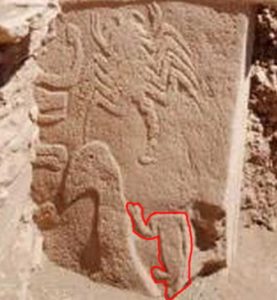 “Stone age men may have believed in an afterlife where they could romp with mythical creatures after scientist’s found what German media said was the world’s oldest erotic picture.
“Stone age men may have believed in an afterlife where they could romp with mythical creatures after scientist’s found what German media said was the world’s oldest erotic picture.
“The image was discovered by a German team digging at the world’s oldest temple who found an image of a 12,000-year-old erect penis but the scientists were keen to stress that there was still a lot to be done to test the various theories.
“The image was found carved on a stone at the Gobekli Tepe temple in Turkey that predates Stonehenge by 7,000 years – and shows a headless man with an erect penis romping with mythical creatures.
“Jens Notroff, an archaeologist and member of the team researching the site of Göbekli Tepe under the direction of Prof. Schmidt, said: “In the picture you can clearly see on the carving a man’s body with an erect penis.
“There is also a giant vulture and a scorpion – and a strange disk that could be the sun.
“Notroff added: “The man’s head is missing. The head was seen as the carrier of the soul so a depiction without a head indicates it is meant to represent the fact that he had died and moved on into the afterlife.
“In this case the dead man has already passed over – hence his head is missing. But to be honest we are still working on figuring out the meaning of the depictions. We see the signs – but cannot understand their meaning.”
Of course, given The Urantia Book’s account of Adam and Eve as genetic uplifters from another world, the erection connection is an obvious point to make. But this is even more intriguing when considered along with comments in The Urantia Book about how Adam and Eve were able to travel around back then on the backs of giant birds. In recounting their first days on the planet, the authors state:
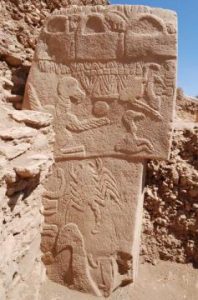 (74:3.4) The third day was devoted to an inspection of the Garden. From the large passenger birds — the fandors — Adam and Eve looked down upon the vast stretches of the Garden while being carried through the air over this, the most beautiful spot on earth.
(74:3.4) The third day was devoted to an inspection of the Garden. From the large passenger birds — the fandors — Adam and Eve looked down upon the vast stretches of the Garden while being carried through the air over this, the most beautiful spot on earth.
Regarding the general appearance of large passenger birds in the early history of mortal races, and the fandors, in particular, The Urantia Book also says:
(52:1.5) Early evolutionary man is not a colorful creature. In general, these primitive mortals are cave dwellers or cliff residents. They also build crude huts in the large trees. Before they acquire a high order of intelligence, the planets are sometimes overrun with the larger types of animals. But early in this era mortals learn to kindle and maintain fire, and with the increase of inventive imagination and the improvement in tools, evolving man soon vanquishes the larger and more unwieldy animals. The early races also make extensive use of the larger flying animals. These enormous birds are able to carry one or two average-sized men for a nonstop flight of over five hundred miles. On some planets these birds are of great service since they possess a high order of intelligence, often being able to speak many words of the languages of the realm. These birds are most intelligent, very obedient, and unbelievably affectionate. Such passenger birds have been long extinct on Urantia, but your early ancestors enjoyed their services.
(66:5.6) It was in these days [about 500,000 years ago] that carrier pigeons were first used, being taken on long journeys for the purpose of sending messages or calls for help. Bon’s group were successful in training the great fandors as passenger birds, but they became extinct more than thirty thousand years ago.
Associating the carving of the erect headless man on what appears to be the back of a giant bird with The Urantia Book’s account of Adam and Eve riding on the backs of giant birds is not the only comparison that bears mentioning. The diverse assortment of animals, somewhat predominated by dangerous creatures, also has connections to The Urantia Book’s story about life in the Garden of Eden.
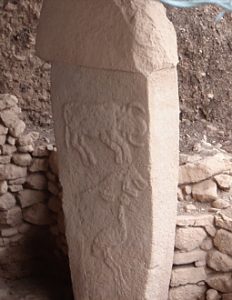 (73:4.1) When Material Sons, the biologic uplifters, begin their sojourn on an evolutionary world, their place of abode is often called the Garden of Eden because it is characterized by the floral beauty and the botanic grandeur of Edentia, the constellation capital. Van well knew of these customs and accordingly provided that the entire peninsula be given over to the Garden. Pasturage and animal husbandry were projected for the adjoining mainland. Of animal life, only the birds and the various domesticated species were to be found in the park. Van’s instructions were that Eden was to be a garden, and only a garden. No animals were ever slaughtered within its precincts. All flesh eaten by the Garden workers throughout all the years of construction was brought in from the herds maintained under guard on the mainland.
(73:4.1) When Material Sons, the biologic uplifters, begin their sojourn on an evolutionary world, their place of abode is often called the Garden of Eden because it is characterized by the floral beauty and the botanic grandeur of Edentia, the constellation capital. Van well knew of these customs and accordingly provided that the entire peninsula be given over to the Garden. Pasturage and animal husbandry were projected for the adjoining mainland. Of animal life, only the birds and the various domesticated species were to be found in the park. Van’s instructions were that Eden was to be a garden, and only a garden. No animals were ever slaughtered within its precincts. All flesh eaten by the Garden workers throughout all the years of construction was brought in from the herds maintained under guard on the mainland.
The artwork at Gobekli Tepe is reasonably consistent with The Urantia Book’s account of Adam and Eve’s unfortunate departure from the Garden of Eden. Lacking evidence of a specific totem animal and given the variety of dangerous animals, the carvings can be interpreted to reflect the trauma of having to leave their original, protected garden.
Another noteworthy aspect of the art and architecture concerns the placement of stones and the markings on them indicating that they represent people. The rooms are round and feature two larger stones in the center. Consider this configuration in light of the following two excerpts about the relationship between Adam and Eve and the family practices of their descendants, the Andites.
(84:7.29) Human society would be greatly improved if the civilized races would more generally return to the family-council practices of the Andites. They did not maintain the patriarchal or autocratic form of family government. They were very brotherly and associative, freely and frankly discussing every proposal and regulation of a family nature. They were ideally fraternal in all their family government. In an ideal family filial and parental affection are both augmented by fraternal devotion.
Ancient Scientific Teachings and Spiritual Practices
The Science of Procreation
With the account of Adam and Eve coming to Urantia as genetic uplifters with full knowledge and understanding of what they were on our planet to do, an obvious question to ask is: “What did they teach human beings about procreation?”
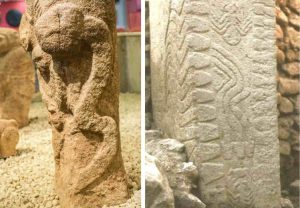 (74:7.22) Adam endeavored to teach the races sex equality. The way Eve worked by the side of her husband made a profound impression upon all dwellers in the Garden. Adam definitely taught them that the woman, equally with the man, contributes those life factors which unite to form a new being. Theretofore, mankind had presumed that all procreation resided in the “loins of the father.” They had looked upon the mother as being merely a provision for nurturing the unborn and nursing the newborn.
(74:7.22) Adam endeavored to teach the races sex equality. The way Eve worked by the side of her husband made a profound impression upon all dwellers in the Garden. Adam definitely taught them that the woman, equally with the man, contributes those life factors which unite to form a new being. Theretofore, mankind had presumed that all procreation resided in the “loins of the father.” They had looked upon the mother as being merely a provision for nurturing the unborn and nursing the newborn.
Note that the sperm-like carvings are depicted individually as well as swimming in large numbers. This suggests an understanding of the fact that one specific sperm gets attached to one egg and that semen contains a large number of sperm cells.
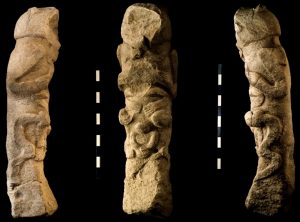 In the statuette image with the front view plus side views, note the three sets of arms and hands. Father, mother, child? And on both sides of the child are large sperm-like carvings. The association of the sperm-like carvings around the child image suggests an awareness of the connection. And the child seems to be depicted as only half way out the womb, which further supports interpreting this in terms of their understanding of fertility. Snakes are also associated with fertility and rebirth, presumably because they shed their skin. But could it be that the teaching about the nature of sperm got lost, while the stone-carved image remained there, ever ready to be associated with an animal that can be seen? Perhaps in this way the meaning was preserved, while the more sophisticated biological understanding, which would have been non evolutionary knowledge, was lost with the passage of time.
In the statuette image with the front view plus side views, note the three sets of arms and hands. Father, mother, child? And on both sides of the child are large sperm-like carvings. The association of the sperm-like carvings around the child image suggests an awareness of the connection. And the child seems to be depicted as only half way out the womb, which further supports interpreting this in terms of their understanding of fertility. Snakes are also associated with fertility and rebirth, presumably because they shed their skin. But could it be that the teaching about the nature of sperm got lost, while the stone-carved image remained there, ever ready to be associated with an animal that can be seen? Perhaps in this way the meaning was preserved, while the more sophisticated biological understanding, which would have been non evolutionary knowledge, was lost with the passage of time.
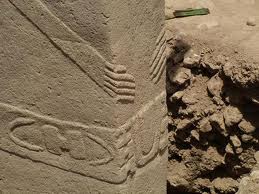 In the image of one of the pillars with fingers wrapping around the corners, note the part of the carving that looks like two half circles with an “H” in the middle. Given the information about Adam teaching people about “those life factors which unite to form a new being,” how might we interpret this symbol consistent with what we know today about biology?
In the image of one of the pillars with fingers wrapping around the corners, note the part of the carving that looks like two half circles with an “H” in the middle. Given the information about Adam teaching people about “those life factors which unite to form a new being,” how might we interpret this symbol consistent with what we know today about biology?
Consider that the two half circles represent the egg and that the “H” symbolizes male and female sex cells joining at the centromere. Today, we think of the chromosome more as a long legged “X” because we now have pictures of chromosomes. But what if you never saw one and you were simply told that two strands of stuff, one from the man and one from the women, get joined in the egg? It is worth noting, of course, that the height of this symbol is in the reproductive area, generally speaking. And the symbol on the shorter side is consistent with a symbolic representation of a penis going into a vagina.
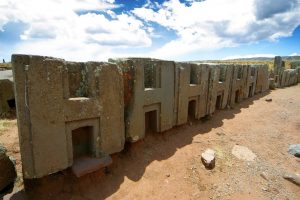 The “H” shape also plays a predominant role in the mysterious megalithic architecture of Puma Punku in Bolivia, as well. It sure seems like some people truly thought that this shape was extremely important to an understanding about life.
The “H” shape also plays a predominant role in the mysterious megalithic architecture of Puma Punku in Bolivia, as well. It sure seems like some people truly thought that this shape was extremely important to an understanding about life.
(78:5.4) By 12,000 B.C. three quarters of the Andite stock of the world was resident in northern and eastern Europe, and when the later and final exodus from Mesopotamia took place, sixty-five per cent of these last waves of emigration entered Europe. . . .
(78:5.7) One hundred and thirty-two of this race, embarking in a fleet of small boats from Japan, eventually reached South America and by intermarriage with the natives of the Andes established the ancestry of the later rulers of the Incas. . . .
(78:5.8) The migratory conquests of the Andites continued on down to their final dispersions, from 8000 to 6000 B.C. As they poured out of Mesopotamia, they continuously depleted the biologic reserves of their homelands while markedly strengthening the surrounding peoples. And to every nation to which they journeyed, they contributed humor, art, adventure, music, and manufacture. They were skillful domesticators of animals and expert agriculturists.
[Editor’s note: The inspiration for taking a crack at interpreting the “H” came from a genetics report, sent to me by Luis Marco, that gives noteworthy support to The Urantia Book‘s dating of both the Sangik races and the Neanderthals. See the Double Dual Origin of Modern Man and pre-Modern Man Research Page to follow up on this 2019 research report out of UC Davis.]
Many ancient Mesopotamian and Egyptian carvings depict divine beings with hats that resemble fish heads. And the tradition of presenting male and female together as godheads of equal status is abundantly presented in ancient carvings from these areas. The resemblance between sperm and fish and their common relationship to the evolving history of these carvings, leads to speculation about whether these fish head hats are symbolic of the genetic uplift brought by Adam and Eve. Consider that the Pope’s hat reflects this long history of fish head hats. [Slated for development, Topical Study: Fish Head Hats.]
There are even Egyptian carvings that depict the collection of the semen, which is consistent with The Urantia Book‘s description of the aftermath of the Adamic default:
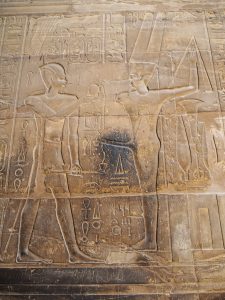 (76:4.8) After becoming established in the second garden on the Euphrates, Adam elected to leave behind as much of his life plasm as possible to benefit the world after his death. Accordingly, Eve was made the head of a commission of twelve on race improvement, and before Adam died this commission had selected 1,682 of the highest type of women on Urantia, and these women were impregnated with the Adamic life plasm. Their children all grew up to maturity except 112, so that the world, in this way, was benefited by the addition of 1,570 superior men and women. Though these candidate mothers were selected from all the surrounding tribes and represented most of the races on earth, the majority were chosen from the highest strains of the Nodites, and they constituted the early beginnings of the mighty Andite race. These children were born and reared in the tribal surroundings of their respective mothers.
(76:4.8) After becoming established in the second garden on the Euphrates, Adam elected to leave behind as much of his life plasm as possible to benefit the world after his death. Accordingly, Eve was made the head of a commission of twelve on race improvement, and before Adam died this commission had selected 1,682 of the highest type of women on Urantia, and these women were impregnated with the Adamic life plasm. Their children all grew up to maturity except 112, so that the world, in this way, was benefited by the addition of 1,570 superior men and women. Though these candidate mothers were selected from all the surrounding tribes and represented most of the races on earth, the majority were chosen from the highest strains of the Nodites, and they constituted the early beginnings of the mighty Andite race. These children were born and reared in the tribal surroundings of their respective mothers.
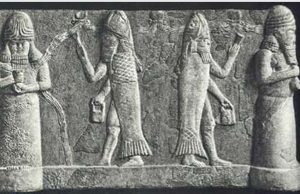 (78:3.6) A blended colored race, about this time greatly reinforced by arrivals [of Adamites] from Mesopotamia, held forth in Egypt and prepared to take over the disappearing culture of the Euphrates valley.
(78:3.6) A blended colored race, about this time greatly reinforced by arrivals [of Adamites] from Mesopotamia, held forth in Egypt and prepared to take over the disappearing culture of the Euphrates valley.
(78:6.5) Ten per cent of these fleeing Andites made their way across Arabia and entered Egypt.
(78:6.8) The cultural age of the second garden was terminated by the increasing infiltration of the surrounding inferior stocks. Civilization moved westward to the Nile and the Mediterranean islands, where it continued to thrive and advance long after its fountainhead in Mesopotamia had deteriorated. And this unchecked influx of inferior peoples prepared the way for the later conquest of all Mesopotamia by the northern barbarians who drove out the residual strains of ability. Even in later years the cultured residue still resented the presence of these ignorant and uncouth invaders.
Integrating Scientific Knowledge with Spiritual Practices
There is a paragraph in The Urantia Book about how certain glandular activity has an impact on “inherent imagination and spiritual receptivity.”
(49:5.19) 3. Spirit-reception series.There are three groups of mind design as related to contact with spirit affairs. This classification does not refer to the one-, two-, and three-brained orders of mortals; it refers primarily to gland chemistry, more particularly to the organization of certain glands comparable to the pituitarybodies. The races on some worlds have one gland, on others two, as do Urantians, while on still other spheres the races have three of these unique bodies. The inherent imagination and spiritual receptivity is definitely influenced by this differential chemical endowment.
It seems, perhaps in an effort to not provide scientific information that we can figure out for ourselves, the revelators did not specifically mention the pituitary gland, instead using a comparison to the pituitary as part of providing cosmological teachings that are beyond human discovery.
Science has discovered the pineal gland’s relationship to sleep. From Wikipedia: “The pineal gland produces melatonin, a serotonin-derived hormone which modulates sleep patterns in both circadian and seasonal cycles. The shape of the gland resembles a pine cone from which it derived its name.” A gland responsible for taking us out of wakeful consciousness and through the brainwave patterns involved with sleep could be considered a rather obvious biological mechanism for “inherent imagination and spiritual receptivity.”
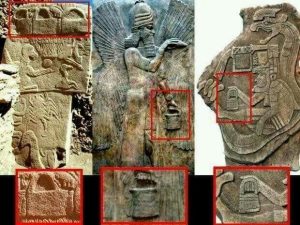 Some ancient carvings from Egypt and Mesopotamia depict beings (sometimes with an animal head, sometimes with a human head) that hold a handbag in one hand and a pine cone in the other. The pine cone is generally believed to represent the pineal gland. The handbag carvings look stylistically similar to the carvings at the top of the monolith at Gobekli that features the headless man with an erection, seated on the back of giant bird.
Some ancient carvings from Egypt and Mesopotamia depict beings (sometimes with an animal head, sometimes with a human head) that hold a handbag in one hand and a pine cone in the other. The pine cone is generally believed to represent the pineal gland. The handbag carvings look stylistically similar to the carvings at the top of the monolith at Gobekli that features the headless man with an erection, seated on the back of giant bird.
The relationship between psychoactive substances for use both as medicine and for religious purposes in ancient cultures is nothing new. From the Wikipedia page: Psychoactive drug:
Psychoactive drug use can be traced to prehistory. There is archaeological evidence of the use of psychoactive substances (mostly plants) dating back at least 10,000 years, and historical evidence of cultural use over the past 5,000 years.[4] The chewing of coca leaves, for example, dates back over 8,000 years ago in Peruvian society.[5][6]
Medicinal use is one important facet of psychoactive drug usage. However, some have postulated that the urge to alter one’s consciousness is as primary as the drive to satiate thirst, hunger or sexual desire.[7] Supporters of this belief contend that the history of drug use and even children’s desire for spinning, swinging, or sliding indicate that the drive to alter one’s state of mind is universal.[8]
One of the first people to articulate this point of view, set aside from a medicinal context, was American author Fitz Hugh Ludlow (1836–1870) in his book The Hasheesh Eater (1857):
This article by Bruce Fenton, ancient mysteries researcher, has a number of handbag images and perspectives worth considering. [Slated for development, Topical Study: The Pineal (or God) Gland.]
For an excellent understanding of how this topic relates to the development Judeo-Christian culture, here is an interview by professor and well-known author Jordan Peterson. He starts with author Brain Muraresku—The Immorality Key. And then he brings in author and professor Carl Ruck—The Road to Eleusis.
The Big Picture
The Urantia Book’s account of the fate of the Adamites does a lot to help explain what is so terribly confusing about Gobekli Tepe to anthropologists and archaeologists. And when considered in conjunction with the Adam and Eve Report and the Garden of Eden Report, the way The Urantia Book explains the multifaceted mysteries of Gobekli Tepe is all the more impressive!
Additional Updates:
Andrew Collins page on Gobekli Tepe.
June 2017 National Geographic article on Gobekli Tepe skull markings.
December 2011 World Heritage Fund Report: Gobekli Tepe has earliest evidence for development of concrete.
An “Evolutionary Revelation” conference was hosted by Byron Belitsos in June 2014. This presentation by Halbert Katzen addresses issues related to the Urantia revelation’s progressive acceptance, as this relates to how new discoveries and scientific advances increasingly support history in The Urantia Book. A review of the Gobekli Tepe Report is part of this presentation.
UK, Daily Mail article from 2011 that speculates about Gobekli Tepe and the Garden of Eden.
Go to Topical Studies page.
Go to UBtheNEWS Report List page.